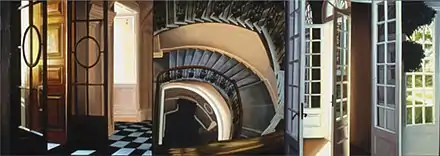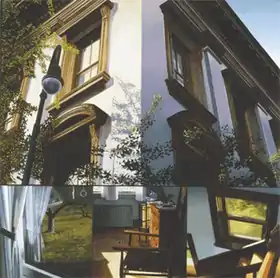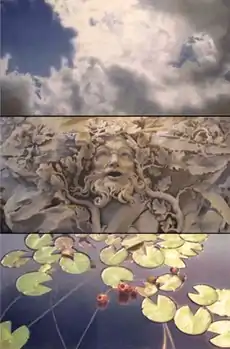Leigh Behnke
Leigh Behnke (born 1946) is an American painter based in Manhattan in New York City,[1] who is known for multi-panel, representational paintings that investigate perception, experience and interpretation.[1][2][3] She gained recognition in the 1980s, during an era of renewed interest in imagery and Contemporary Realism.[4][5][6][7]
Leigh Behnke | |
|---|---|
| Born | 1946 Hartford, Connecticut, United States |
| Nationality | American |
| Education | New York University, Pratt Institute |
| Known for | Painting |
| Spouse(s) | Don Eddy |
| Awards | Guggenheim Fellowship, E.D. Foundation |
| Website | Leigh Behnke |

Her paintings combine meticulous, realist technique, formal rigor commonly associated with abstraction, and postmodern conceptual strategies, such as fragmentation and deconstruction.[8][9][10] Behnke's art has been exhibited by the Whitney Museum of American Art, National Academy of Sciences and National Academy of Design Museum;[11][12][13] she has been Included in major exhibitions on American Realism and watercolor at the Duke University Museum of Art and Neuberger Museum of Art, and major traveling shows, such as "Real, Really Real, Super Real" (1980–1, San Antonio Museum of Art), "American Realism: 20th Century Drawings and Watercolors" (1985–7, San Francisco Museum of Art), and "New York Realism—Past and Present" (1994–5, Kagoshima City Museum of Art; Tampa Museum of Art).[14][15][5][16][17]
Her work belongs to the public art collections of the New York Public Library, New York Historical Society, and Nelson-Atkins Museum of Art, among others,[18][19][20] and has been discussed in Artforum,[2] Arts Magazine,[21] ARTnews,[22]The New York Times, and The Washington Post. Artforum critic Ronny Cohen described her work as a "sophisticated assault on the conventions of seeing underlying pictorial illusionism";[2] writing about her cityscapes, John Yau called Behnke "an archaeologist of light, a stark factualist."[23] In 2013, she was recognized with a Guggenheim Fellowship; a monograph about her work, Leigh Behnke: Real Spaces, Imagined Lives, was published in 2005.[24][25][3] Behnke teaches at the School of Visual Arts in New York City and is married to the photorealist painter Don Eddy.[20][26]
Early life and career
Behnke was born in Hartford, Connecticut in 1946.[1] She initially studied interior design at the Pratt Institute (BFA, 1969), developing an interest in architecture, but switched to art, producing abstract sculpture that reflected the dominant influence of Minimalism and Constructivism.[27][10][28] During her graduate studies at New York University (MFA, 1976), she explored geometric sculpture and painting that was influenced by Hans Hofmann; a back injury prompted her permanent shift to painting.[20][10][28] Like many Photorealist artists (e.g., Chuck Close, Ralph Goings), Behnke turned from abstraction to representation, seeking a greater connection to experience and a more accessible style; nonetheless, she retained Abstract Expressionism's formal emphasis and concern for the artwork as physical object.[27][29][3] In 1976, she began producing multi-panel paintings investigating sequentiality, perception and temporality, which bore the influence of Monet's color and light studies and of conceptual photographers, such as Hilla Becher, Hanne Darboven and Jan Dibbets.[10][25][30] Art historian Virginia Anne Bonito wrote that in this work Behnke sought to create representational versions of Josef Albers's abstract, chromatic investigations (the "Square" paintings), colorist analogues to Muybridge's stop-action photography, and deconstructions of Cubism.[10]
Behnke rented her first New York studio in 1972, sharing a Christopher Street space with painters John Wesley and Robert Birmelin; soon after, she met future husband, Don Eddy.[30] After completing graduate studies, she exhibited actively, in group shows at the Phoenix Art Museum, Barbara Gladstone Gallery, Institute for Contemporary Art, Richmond, and Whitney Museum, among others,[31][32][11][9][5] and the first of eleven solo exhibitions at Fischbach Gallery (1978), known for representing artists Eva Hesse, Jo Baer, Jane Freilicher and Alex Katz.[33][34][35] In 1979, she began teaching at the School of Visual Arts in New York City; she has taught there for four decades.[30][20]

Work and reception
Behnke emerged in the late-1970s amid resurgent interest in Contemporary Realism and changing norms regarding the relationships between representation and abstraction, referentiality and content.[4][6][36][9] Art historians note that despite changing subject matter, the basic premises of her art have remained remarkably consistent: unpopulated, realist, multi-panel works that explore formal and conceptual issues involving perception, experience, the articulation of space, and the underlying mechanisms of the world.[10][3][29][2] John Arthur compared her associative strategy to montage in film editing, which juxtaposes scenes to create new, unique meanings;[29] curator Christopher Young correlates her method to Ferdinand Saussure's semiotic theories of language and signs.[9] Leda Cempellin relates Behnke's approach to Renaissance narrative devices, the Cubist investigation of reality through fragmentation, and scientific method, which approaches phenomena from multiple perspectives.[3] She and others suggest this approach creates several dichotomies in the work: representational realism and formalist abstraction, order and chaos, classical illusionism and postmodern fragmentation, city and nature, interior and exterior, celestial and terrestrial.[3][2][10]
Early work: 1976–1980
Behnke's early paintings were formally focused and consisted of multi-paneled, meticulously rendered conceptual watercolors based on her photographs of interiors, still lifes, cityscapes or architecture.[27][32][37][36][38] This work examined the effects of carefully manipulated variations in light, perspective and arrangement on color, form, and composition, while also pushing value ranges and color intensity to rare extremes (for watercolor) through dozens of glaze layers, often requiring a month's time in total.[27][6][22][39] Despite its realism, her investigations of color theory and "shadow dramas" of changing light[36] (e.g., the "Time Sequence" and "Light and Intensity Variation" series) often drew comparisons, in formal terms, to the subtle value shifts and grids of Minimalist art.[32][33][40]
Conceptually, Behnke's work of this time confronted the incompatibility between the sculpturally solid and dynamic natures of reality, reconciling change and stability, as well as art historical strategies for capturing experience (Renaissance, cubist and futurist).[27][22] For example, the triptych Time Sequences/Value Changes (1979) investigates compositional and color effects as light and shadow exchange roles in a windowed interior; other works enact a similar strategies with exteriors, or still lifes (Three Spectral Pairs, 1978).[27][10]
_1983.jpg.webp)
Interiors and cityscapes: 1980–1999
By 1980, Behnke's work had evolved in three ways: she added oil paint to her repertoire, increasingly turned to New York City as a subject, and introduced a greater sense of temporality and unfolding, layered meaning through her use of the predella, a horizontal, multi-frame pictorial device of subsidiary, adjoined images often used on early-Renaissance religious altarpieces.[11][7][36][14][41] Her oil paintings successfully adapted watercolor techniques—friskets and layered transparent glazes—that reviewers suggested endow the surfaces with a smooth, "mirror-like believability."[2][10][30] In the four-sequence oil work Light Study with Venetian Blinds (1981), she examined shifting conditions of light, color, and view (as the blinds close); the interiors Geometric Configurations: Variations on A Square (1982) and East Hampton Staircase With Landscape (1986) explored compositional and formal possibilities in predella and triptych formats.[2][12][10]
Behnke's cityscapes used these formats in a similar manner, bringing disparate viewpoints (bird's-eye, low-angle), dramatic changes in scale, and tightly cropped fragments into dialogue with one another; critics Grace Glueck and Gerrit Henry wrote that the composite works expressed "the dynamics of New York City life"[42] and a "questioning aesthetic love."[43][12][17] Works such as Brooklyn Bridge Compositional Study (2nd Version) (1983), Bridge Promenade (1991), Wallace's Heresy and Broken Symmetry (both 1990), often reduced buildings to geometric forms and colliding rhythms, generating visual tension through compressed, activated space.[23][16][2][44] In her presentation of multiple perspectives, Behnke portrayed urban experience as visually complex—continuous, fragmented, dislocated, monumental and transient—and ambiguous in its effects: awe, pleasure, progress, disorientation, claustrophobia.[7][2][17][45][29]

From the 1990s onward, iconography and narrative play an increasing role in Behnke's work, triggering senses of collective history, the past, and time in the dialogue between imagery; she has expanded its scope to include cosmological and natural phenomena, universal forms, and scientific theory.[46][10][3] The images of her stacked, three-panel works, Sidereus Nuncius (1990), Interregnum (1995) and Blind Sight (1996), navigate and contrast varying rhythms, elements (land, water, air, light) and perspectives, progressing bottom to top from microcosm (fish, flowers, grass) to the human environment to macrocosm (the stars); such work often invokes scientific investigation and exploration: Sidereus Nuncius ("Starry Messenger") was an early astronomical book by Galileo Galilei, Wallace's Heresy references natural selection theorist Russel Wallace), and "blind sight" refers to pre-modern navigation methods.[3][2][10] In the architectural triptychs, Archimedes's Dream (1998) and The Paradox of Infinite Regression (1999, above), Behnke explored complex, patterned spatial and geometric relationships and the mathematical form of the spiral or nautilus; critic Hilton Kramer called the latter work "a virtuosic pastiche of Futurism, Cubism and Realism executed with consummate skill."[30][8]

Later work: 1999–
In 1999, Behnke received an E.D. Foundation grant to work on paintings based on Victorian homes, and chose to focus on Sagamore, Theodore Roosevelt's summer estate on Long Island.[3] The resulting "Sagamore" series (1999–2000) used composite imagery, Behnke's own photographs, and information from several sources to project an imagined life onto historical people (domestic staff, the Roosevelts) and the space.[30][3][28] Annie's View (2000) envisioned the house as seen and experienced by a servant, Annie, through four images unified visually by careful attention to the interplay of light and shadow and a strong sense of illusionism.[3][30] Its primary upper panel depicts a corner of the top floor of a large house (where servants traditionally lived) as passers-by would see it; the lower three-scene predella reproduces, successively, the view from Annie's window, her room, and the back staircase, suggesting a fragmented reconstruction of her life there: a view of imagined freedom, the constraint of indoor employment, up-and-down labor.[3][30] Other paintings in the series, such as Entrance for Edith and Alice and Sagamore: Downstairs, depict the home as seen from the Roosevelts' point of view.[3][28]
In recent years, Behnke's imagery has become more varied, incorporating a wider range of elements (carousels, ornamental metalwork and statuary), locations and formats (single-image works) alongside her characteristic studies of architectural spaces and exteriors.[28][47][48] Her 2009 exhibition, "Through the Looking Glass," focused on portals—passages, doors, arches, windows, stairwells—as vehicles for formal play and the evocation of imaginative and real dimensions and spaces; her work since then has often explored mythological iconography, as in Aristotle's Fifth (2016), which employs her tri-part, microcosm-to-macrocosm progression.[28][47][48]
Recognition
Behnke received a John S. Guggenheim Foundation Fellowship in 2013 and grants from the E.D. Foundation (1999, 2000).[24][49] Her work belongs to many public and private art collections, including those of the New York Public Library, New York Historical Society, Butler Institute of American Art, Currier Gallery of Art, Georgetown University, Massachusetts Institute of Technology, Nelson-Atkins Museum of Art, and Springfield Art Museum in Missouri.[18][50][51][19][20]
References
- Smithsonian American Archives of Art. "Don Eddy and Leigh Behnke Papers," Collection. Retrieved November 8, 2019.
- Cohen, Ronny. "Leigh Behnke," Artforum, May 1991. Retrieved November 8, 2019.
- Cempellin, Leda. Leigh Behnke Real Spaces, Imagined Lives, Padova, Italy: Coop. Libraria Editrice Universita di Padova, 2005.
- Rose, Barbara. American Painting: The Eighties, A Critical Interpretation, New York: Vista Press, 1979. Retrieved November 8, 2019.
- Heller, Jules and Nancy. "Leigh Behnke," North American Woman Artists of the Twentieth Century, New York: Garland Publishing, 1995, p. 57–8.
- Raynor, Vivien. "Pooling of Resources Produces Stimulating Success," The New York Times, February 7, 1982.
- Zimmer, William. "Camera's Role as a Tollo Is Growing," The New York Times, April 22, 1984. Retrieved November 8, 2019.
- Kramer, Hilton. "American Upstarts Harley, Homer, Ault Dominate at Armory," The New York Observer, February 26, 2004. Retrieved November 8, 2019.
- Young, Christopher. New Horizons in American Realism, Flint, MI: Flint Institute of Arts, 1991. Retrieved November 8, 2019.
- Bonito, Virginia Ann. Get Real: Contemporary American Realism from the Seavest Collection, Durham, NC: Duke University Museum of Art, 1998. Retrieved November 8, 2019.
- Raynor, Vivien. "Lower Manhattan Unfurled in Federal Hall," The New York Times, February 26, 1982. Retrieved November 8, 2019.
- Welzenbach, Michael. "Cities’ Light in Several Shades," The Washington Post, February 1, 1992. Retrieved November 8, 2019.
- The Washington Sun. "A Celebration of Cities," The Washington Sun, January 23, 1992.
- Raynor, Vivien. "An Attractive Exhibition of What Watercolor Can Do," The New York Times, February 13, 1994. Retrieved November 8, 2019.
- Genocchio, Benjamin. "For the Eyes, Bubble Gum," The New York Times, November 30, 2003. Retrieved November 8, 2019.
- Martin, Alvin. American Realism: Twentieth Century Drawings and Watercolors, New York: Harry N. Abrams, 1986. Retrieved November 8, 2019.
- Dreishpoon, Douglas. "Painting the Town: Some Thoughts on American Urban Realism," New York Realism—Past and Present, Tokyo: The Japan Association of American Art Museums and Brain Trust Inc., 1994. Retrieved November 8, 2019.
- New York Historical Society. "Panoramas: The Big Picture," Press Kits. Retrieved November 8, 2019.
- Nelson-Atkins Museum of Art. "Leigh Behnke, Kaleidoscope, 1989," Objects. Retrieved November 8, 2019.
- School of Visual Arts. "Leigh Behnke," People. Retrieved November 8, 2019.
- Friedman, John R. Arts Magazine, January 1980.
- ARTnews. "New Editions," ARTnews, April 1982, p. 106.
- Yau, John. "Fifteen Ways of Looking at New York," In Honor of the Brooklyn Bridge, New York: Findlay Contemporary, 1983.
- Artforum. "2013 Guggenheim Fellows Announced," Artforum, April 11, 2013. Retrieved November 8, 2019.
- Butler, Sharon. "9 painters receive 2013 Guggenheim Fellowships," Two Coats of Paint, April 15, 2013. Retrieved November 8, 2019.
- Harrison, Helen A. "Art Reviews: 'Together Working,'" The New York Times, February 27, 2000. Retrieved November 8, 2019.
- Marberger, A. Aladar. "New Faces/New Images," Ocular Magazine, Winter 1980.
- Gokduman, Safak Günes. "Light, Time, and Space," RHT Art Magazine, March, 2012, p. 54–61.
- Arthur, John. American Realism: The Precise Image, Tokyo: Asahi Shimbun and The Brain Trust, 1985.
- Hise, Jeri. "Interview with Leigh Behnke," Leigh Behnke Real Spaces, Imagined Lives, Padova, Italy: Coop. Libraria Editrice Universita di Padova, 2005.
- Price, Hardy. "New York Art Scene at Museum," The Arizona, April 25, 1979.
- Ames, Barbara and Julia Boyd. On Paper, Richmond, VA: Institute of Contemporary Art of the Virginia Museum, 1980.
- Poroner, Palmer. "New Directions of the Seventies," Art Speak, 1979.
- The New York Times. "Marilyn C. Fischbach," The New York Times, June 18, 2003. Retrieved November 8, 2019.
- Guiliano, Charles. "At the Galleries," Boston Ledger, Apr. 17, 1981.
- LeClair, Charles. The Art of the Watercolor, Spectrum Books, Prentice Hall, 1985.
- Merrit, John. "On Paper," Richmond Times-Dispatch, September 9, 1980.
- Finch, Christopher. Twentieth Century Watercolors, New York: Abbeville Press, 1988. Retrieved November 8, 2019.
- Mitchell, Mark. "Aiming for Masterpieces," American Watercolor, Spring 1992, p. 90–1.
- DePietro, Anne Cohen. A Feast for the Eyes, Huntington, NY: Heckscher Museum, 1981.
- Chwast, Seymour and Steven Heller. The Art of New York'', New York: Harry N. Abrams, 1983. Retrieved November 8, 2019.
- Glueck, Grace. New York—The Painted City, Salt Lake City, UT: Peregrine Smith Books, 1992. Retrieved November 8, 2019.
- Henry, Gerrit. Leigh Behnke, New York: Fischbach Gallery, 1991.
- Whitney Museum of Modern Art. "Lower Manhattan From Street to Sky," 1982.
- Gallati, Barbara Dayer. American Art Today: Night Paintings, Miami, FL: Frost Art Museum, 1995. Retrieved November 8, 2019.
- New York Magazine. "Exhibitions: Leigh Behnke," New York Magazine, April 4, 1994.
- Behnke, Leigh. Through the Looking Glass: Leigh Behnke, New York: Fischbach Gallery, 2009.
- Behnke, Leigh. Leigh Behnke: Memory and Myth, New York: Fischbach Gallery, 2013.
- John Simon Guggenheim Memorial Foundation. "Leigh Behnke," Fellows. Retrieved November 8, 2019.
- Currier Gallery of Art. "Color Contra-Dictions: Orange Interior Blue Landscape, 1979, Leigh Behnke," Collections. Retrieved November 8, 2019.
- Georgetown University. Victorian Still Life 3, From the Vault. Retrieved November 8, 2019.
External links
- Leigh Behnke official website
- Don Eddy and Leigh Behnke Papers, Smithsonian American Archives of Art.
- Leigh Behnke, Guggenheim Fellow page
